16 - Soils, Paleosols, and Paleoenvironmental Reconstruction
Published online by Cambridge University Press: 12 January 2024
Summary
Paleosols as Palimpsests
Commonly, the first step in a soil geomorphic study is to ascertain the age of the soil or surface and then use information obtained from the soil to better understand the character of the geologic timespan during which the soil has formed. That is, we try to determine the starting and ending points of the soil-forming interval – when the surface was stable and the soil was forming. Soils are, however, an integration of the many surficial processes that occur over these time intervals. No one soil-forming interval is a monotony of similar situations, factors, and inputs. Climate ebbs and flows, vegetation changes, and surfaces gradually aggrade or erode. For this reason, Don Johnson often argued that all soils are polygenetic (Johnson 2002, Johnson et al. 2005; see Chapter 12). The older the soil, the more likely it is to have experienced a wider variety of inputs, and the more polygenetic it will be – the more like a palimpsest it will be.
A palimpsest (Latin palimpsestus, scraped again) is a parchment used one or more times, with earlier writings having been incompletely erased from it. Recently erased passages are not very difficult to make out, but older passages are much more difficult, yet not impossible, to read and interpret. It simply takes skill and patience. In this sense, soils are palimpsests, and in this chapter we provide information useful to their interpretation. Interpreting such a palimpsest is an exciting challenge and an important application of soil geomorphology (Catt 1990). The information gleaned from pedopalimpsests is indicative of past soil-forming intervals and the changes that they may have undergone with respect to climate, vegetation, or geomorphology (Rutter 2009).
In this chapter we discuss how a careful reading of soil palimpsests, coupled with a knowledge of how soil development is related to contemporary soil-forming processes, can often (for older soils) provide a wealth of information about conditions under which old or buried soils formed (Sheldon and Tabor 2009). That is, soils – because they are palimpsests – can be highly useful keys to conditions of the geologic past (Catt 1991). This chapter must by necessity follow chapters on pedogenesis, weathering, pedoturbation, parent materials, and soil geomorphology, because paleopedologic, paleoclimatic, and paleogeomorphic interpretations require a thorough knowledge of contemporary processes.
- Type
- Chapter
- Information
- SoilsGenesis and Geomorphology, pp. 605 - 637Publisher: Cambridge University PressPrint publication year: 2015

